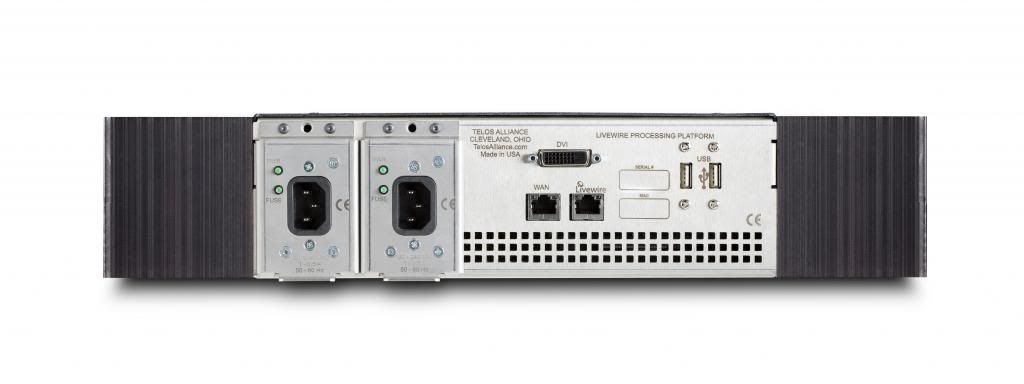StudioEngine Mixing Engine Overview {LEGACY PRODUCT}
The networked Axia StudioEngine provides bulletproof mixing console signal processing for Element® and Fusion™ mixing consoles. Each StudioEngine is equipped with multiple simultaneous inputs, outputs, mix-minus feeds, monitor signals, etc. and can provide EQ for multiple channels, voice dynamics, studio headphone processing and multiple VMix (Virtual Mixer) channels.
The StudioEngine is fanless for cool, silent in-studio deployment, and is equipped with Gigabit Ethernet ports for network connection, and dual-redundant, field-replaceable internal power supplies with automatic switching for complete peace of mind.
In addition to providing mixing for physical console surfaces, StudioEngine can be used in conjunction with Axia SoftSurface Virtual Console software to create a powerful “virtual console” of up to 48 faders that’s controlled with a standard Windows-based laptop — perfect for places where space constraints do not permit a physical mixing device.
StudioEngine Mixing Engine Features {LEGACY PRODUCT}
-
Fanless design with heavy machined heat-sinks is completely silent in-studio.
-
Front-panel OLED display delivers monitors power status, operating temperature, and a fast manual setup option.
-
Telecom grade dual-redundant power supplies are designed for maximum uptime under harsh conditions. Automatic, seamless switching.
-
Field-replaceable, internally fused fault-protected power modules change out in under 1 minute.
-
Dedicated Gigabit LAN interface for Livewire and System Administration.
- AES67 support.
StudioEngine Mixing Engine In Depth {LEGACY PRODUCT}
Mixing Power, a la carte.
Although Axia mixing consoles resemble traditional broadcast consoles, no audio is actually mixed by or even passes through their faders. Instead, think of Axia consoles as a “remote control” for Axia DSP- based mixing engines.
The rugged StudioEngine is a standalone mixing engine for use with Axia Element and Fusion control surfaces; it has no audio I/O of its own, instead allowing you maximum flexibility in designing your audio network with a la carte I/O using Axia xNode IP-Audio interfaces. In this way, you can construct bespoke systems to suit your specific needs.

The StudioEngine itself is an extremely powerful mixing device, based on a blazingly-fast Intel processor that can out-perform even the largest dedicated-DSP embedded designs. The StudioEngine accesses audio streams, modifies them, and then presents the resulting streams back to the network as program output (or monitor output, or mix-minus output, et cetera). This approach is ideally suited to a network- based audio architecture since all input and output streams are routed through a Gigabit Ethernet port.

To deliver the reliability and ultra-low latency required, we equipped the StudioEngine with a fast, robust version of the Linux real-time operating system. Then we optimized our engine processing program so that total input to output latency is just a few hundred microseconds.
In fact, each StudioEngine has so much CPU power, it can outperform the very largest digital or router- based consoles, with multiple simultaneous inputs, outputs, mix-minus feeds, monitor signals, etc.
for consoles as large as 40 faders. It can even provide EQ for and voice dynamics for multiple audio channels, as well as multiple VMix (virtual mixer) channels that allow combination of multiple audio channels on “virtual faders” that can then be mapped to a single physical fader. One StudioEngine supplies mixing power for even the largest Fusion or Element console.
Additionally, StudioEngine can be paired with Axia SoftSurface software to create a “virtual console” controlled by any computer with the Windows operating system — an ideal way of putting big mixing power into very small spaces.
StudioEngine Mixing Engine Specifications {LEGACY PRODUCT}
Power Supply AC Input
-
Auto-sensing supply, 100VAC to 240VAC, 50 Hz to 60 Hz, IEC receptacle, internal fuse
-
Power consumption: 100 Watts
Operating Temperatures
- -10 degrees C to +40 degrees C, <90% humidity, no condensation
Dimensions (HxWxD) and Weight
-
3.5 x 19 x 15 inches, 15 pounds
Network Interface
- 1x 1000BASE-T ports, standard RJ-45 connectors.
Audio Processing
Equalizer
-
Frequency Bands: 20Hz to 320Hz, 125Hz to 2KHz, 1.25KHz to 20KHz.
-
Cut/Boost range on each band: -25dB to +15dB.
-
Q-factor: Automatic - bandwidth varies based on amount of cut or boost.
Compressor
-
Threshold: -30dB to 0dB Ratio: 1:1 to 16:1
-
Post-processor Trim Level: Adjustable from -20dB to +20dB
Expander/Noise Gate
-
Threshold: -50dB to 0dB Ratio: -30dB to 0dB
De-esser
- Threshold: -20dB to 0dB Ratio: 1:1 to 8:1
Regulatory
North America: FCC and CE tested and compliant, power supply is UL approved.
Europe: Complies with the European Union Directive 2002/95/EC on the restriction of the use of certain hazardous substances in electrical and electronic equipment (RoHS), as amended by Commission Decisions 2005/618/EC, 2005/717/ EC, 2005/747/EC (RoHS Directive), and WEEE.
The maximum total length of all CANBus cabling associated with a specific Element should never exceed 100 feet (30 m). This includes the length of the power supply cable that connects the Element surface to the PowerStation or Studio Engine, since this is also a part of the CANBus. Best practices dictate keeping the CAN bus length to a minimum: a practical maximum is about 40 ft. Proper termination is also required.
The Engine should be between 40-50 degrees Celsius, with maximum temperature spikes into the 50 degree range. Any piece of gear that is running consistently in the 60 degree Celsius range is not being properly ventilated
Press and hold the control knob for 6 seconds during boot up of the device.






















































